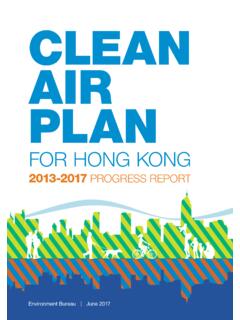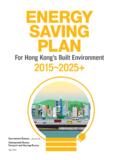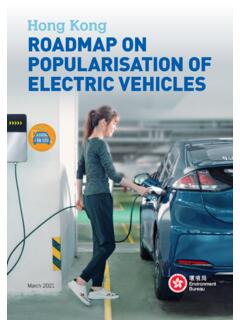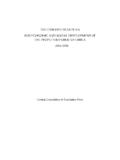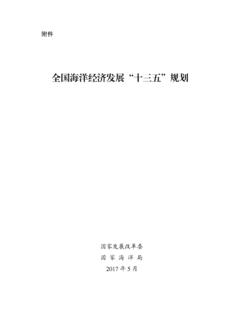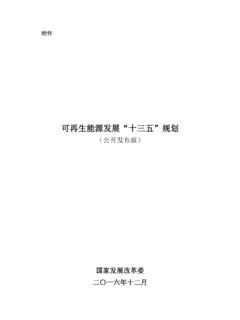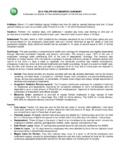Transcription of A Clean Air Plan for Hong Kong - enb.gov.hk
1 I Contents 1 Message from the Chief Executive 3 1 | After the Haze 4 2 | Introduction 12 3 | The Basis of the Clean Air plan 13 4 | Our Air Quality Management System 14 5 | Reducing Roadside Air Pollution 27 6 | Reducing Marine Emissions 33 7 | Emission Control of Power Plants 36 8 | Emission Control of Non-Road Mobile Machinery (NRMM) 37 9 | Conclusion 39 10 | Footnotes and abbreviations PAGE TITLE 1 Message from the Chief ExecutiveIt is a priority of this Government to reduce air pollution and the associated risks to people s health.
2 Improving Hong Kong s air quality is a complex exercise that requires strong understanding of environmental sciences, ability to chart evidence-based multi-disciplinary policies, effective feedback and assessment mechanisms and financial resources to take action. We are fortunate to have these conditions in place, together with the active collaboration and determination within the HKSAR Government to deliver results. I commend the Environment Bureau on presenting A Clean Air plan for Hong Kong in collaboration with the Transport and Housing Bureau, Food and Health Bureau, Development Bureau, as well as other relevant departments.
3 CY LeungChief ExecutiveHong Kong Special Administrative Region 2 Our pursuitDevelop a comprehensive planOur approachAdopt evidence-based approach to understand complexity and identify solutionsBasis of planImprove public health; and collaborate with key stakeholders including investing time in regional effortsAir quality management systemImprove all aspects needed to understand, manage and review policies and measuresRoadside air qualityTarget major emission sources, as well as use transport management and urban planning to reduce pollution Marine emissionsMandate fuel switch at berth for ocean-going vessels, use cleaner marine diesel for other vessels; and build on-shore power facilities for the Kai Tak Cruise TerminalPower generationCap emissions from local power plants.
4 Review fuel mix and promote demand-side management to improve energy efficiencyNon-road mobile machineryRegulate new machinery and existing machinery which has not been exemptedA Clean AIR PLANFOR HONG KONG 3 1 | After the HazeAir quality should not be just a passing concern it is the envelope within which all our daily activities take place. Air pollution does not have to be part and parcel of life in Hong Kong. Strengthening our ability to reduce air pollution saves billions of dollars in future public health care costs, missed work days, school absences, not to mention the discomfort and suffering from preventable illnesses and premature death.
5 Our residents are impatient for improvement in air quality. They are becoming more and more knowledgeable about the issues and more and more pointed in the questions they demand answers to. Experts and activists are helping to raise public awareness about air quality and health issues, and it is just a matter of time that technologists and artists will join hands to create easy-to-understand apps for personal mobile devices to keep people informed about air quality in districts and even specific pollution black spots . We welcome the rise in knowledge and expectation within the community.
6 This is the basis for Hong Kong to make choices, change behaviour where necessary and upgrade practices in controlling emission from major sources, including vehicles, vessels and power plants. We commit to engage stakeholders and the public regularly to share knowledge and future, there will be ever more real-time, on-line air quality information that is locally and also nationally relevant. Our goal is for Hong Kong to be among the best in the world in understanding air quality so that we can continue to fight air pollution aggressively. In two to three years, our roadside air pollution levels will begin to drop as the result of efforts to Clean -up the city s oldest, dirtiest vehicles kick-in.
7 In four to five years, our roadside air quality will begin to improve more significantly as the mix of the commercial vehicle fleet change. By then, ships too will be using cleaner fuels while berthing, instead of continuing to burn high sulphur bunker fuel. Before the turn of the decade, the whole of the waters of Hong Kong, Macao and the Pearl River Delta may well be a special designated Emission Control Area. Also by then, our rail network will be more extensive. Commuters will find their daily journeys on rail, buses and at inter-changes smoother and more pleasant. Hybrid and electric vehicles of various types will be plying our roads in larger numbers.
8 Many parts of the city will offer an exceptionally pleasant ambience for pedestrians, such as along the harbour-front, and cyclists can travel long distances along defined paths in the New Territories and even parts of Kowloon and Hong Kong Island. By 2020, regional air quality will be much improved as a result of tighter regulation in Hong Kong and on the Mainland for both industry and transportation. Hong Kong will have designed effective programmes together with Guangdong to promote cleaner technologies in factories that will reduce smoggy conditions. Guangdong and Hong Kong are already partners in cleaning-up.
9 We will see more blue sky days not only in Hong Kong but also in Macao and the Pearl River Delta. By 2030, old behaviour will have changed all emissions sources will be more stringently controlled throughout the region. Green and Clean living will have taken root. This is our pursuit. The many initiatives, schemes and programmes highlighted in this document involve many stakeholders and also the community as a whole to step-up. We look forward to your active support to improve air goal is for Hong Kong to be among the best in the world in understanding air quality so that we can continue to fight air pollution aggressively 4 2 | IntroductionWe want to first set the stage to explain the background to Hong Kong s air quality before stating the new Clean air plan because the plan is designed to address our specific circumstances.
10 A good place to start is to consider the questions frequently asked by the public. A: How does air pollution affect Hong Kong?We need to consider both general air quality and localized air quality, such as at , greatly expanded industrialization in the Pearl River Delta (PRD), large population increases and economic growth in the entire Hong Kong-PRD region had great impact on the environment, including air quality. Many more activities and many more people now share the same Kong-Macao-PRD share the same air-shed, home to some 60 million people and is one of the world s major industrial and logistics Hong Kong companies have significant investments in manufacturing, as well as port and transport facilities in the In other words, this is a region with high emissions arising from a large variety of economic activities.
